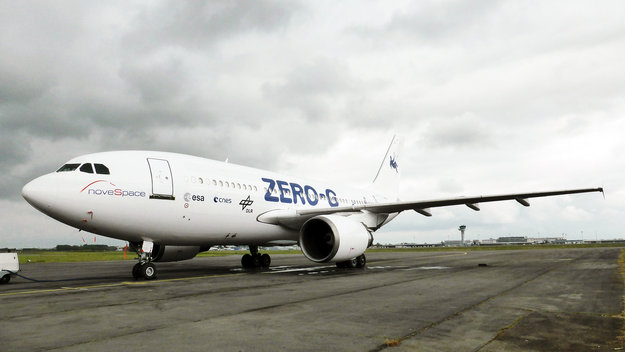Moon and Mars on a plane
26 September 2016 Who wouldn’t want to run an experiment in lunar or martian gravity? ESA is offering European researchers the chance to test their theories on aircraft flights that offer 20 seconds of reduced gravity.
“Partial-gravity flights are rare and offer a unique opportunity to conduct research in conditions that have only been reproduced a handful of times,” notes ESA’s head of human research, Jennifer Ngo-Anh.
ESA often conducts ‘parabolic’ flights using a refitted Airbus A310 that flies up and down on a rollercoaster ride. At the top of the curve the passengers and experiments experience reduced gravity.
Commonly, the pilots climb at 45° to offer zero-gravity for 20 seconds at a time. By adjusting the angle, the pilots can simulate other gravity levels – from the Moon’s one sixth of what we feel on Earth to a martian one third of Earth’s gravity.
Parabolic flights are useful for scientific and technology researchers, offering the unique opportunity to control experiments in reduced gravity with humans as test subjects.
“In addition to being the only way to test experiments in gravity levels found on the Moon and Mars, parabolic flights that simulate reduced gravity are exciting for everyone involved and they offer more experiment time than ‘normal microgravity’ flights,” says Jennifer. “We are looking forward to a great mix of experiments from around the world.”
How do you walk on Mars?
Researchers from previous experiments run on reduced-gravity parabolic flights have had their results published in the prestigious Nature magazine. A novel experiment investigated how astronauts would walk on Mars – the ideal walking speed turns out to be around half the speed on Earth – important information for planning missions to the Red Planet.
What would you like to know about how humans adapt to living in reduced gravity?
Related articles

Space for dessert?
09 July 2012
09 July 2012
Related articles

26 March 2003 The only way to get away from the sensation and effects of gravity is to give in to it. That is why the 'Zero-G' Airbus A300 that ESA uses for parabolic flights has to 'freefall' through the air - with no force other than gravity acting on it - to gen...
VERSIÓN EN ESPAÑOL :
Marte y la Luna a bordo de un avión
27 septiembre 2016 ¿Quién no querría realizar experimentos bajo la gravedad lunar o marciana? ESA ofrece a los investigadores europeos la oportunidad de probar sus teorías en vuelos que ofrecen 20 segundos de gravedad reducida.
“Los vuelos con gravedad parcial son poco frecuentes y constituyen una ocasión única para llevar a cabo investigaciones en condiciones que muy pocas veces se han reproducido”, apunta Jennifer Ngo-Anh, directora de investigación humana de la ESA.
La ESA realiza con frecuencia vuelos ‘parabólicos’ con un Airbus A310 reacondicionado que asciende y desciende como una montaña rusa. En el máximo de la curva, los pasajeros y los experimentos disfrutan de gravedad reducida.
Normalmente, los pilotos ascienden a 45° para ofrecer gravedad cero durante 20 segundos por vuelo. Además, pueden simular otros niveles de gravedad ajustando el ángulo: desde la gravedad de la Luna, que es un sexto de la de la Tierra, a la marciana, un tercio de la de nuestro planeta.
Los vuelos parabólicos resultan útiles para investigadores de ciencia y tecnología, ya que ofrecen una oportunidad única para controlar experimentos bajo gravedad reducida con humanos como sujetos de ensayo.
“Además de ser la única forma de probar experimentos en niveles de gravedad como los de la Luna o Marte, los vuelos parabólicos que simulan la gravedad reducida resultan interesantísimos para todos los participantes y ofrecen más tiempo para experimentar que los vuelos ‘normales’ de microgravedad —añade Jennifer—. Estamos deseando recibir una fantástica selección de experimentos de todo el mundo”.
Cómo caminar en Marte
Investigadores de experimentos anteriores realizados durante vuelos parabólicos de gravedad reducida han visto publicados sus resultados en la prestigiosa revista Nature. Un novedoso experimento investigaba cómo los astronautas caminarían en Marte: la velocidad ideal para caminar resultó ser aproximadamente la mitad de la velocidad sobre la Tierra, un dato importante a la hora de planificar misiones en el Planeta Rojo.
¿Qué te gustaría saber sobre la adaptación humana a la gravedad reducida?
Guillermo Gonzalo Sánchez Achutegui
ayabaca@gmail.com
ayabaca@hotmail.com
ayabaca@yahoo.com
Inscríbete en el Foro del blog y participa : A Vuelo De Un Quinde - El Foro!




No hay comentarios:
Publicar un comentario
Por favor deja tus opiniones, comentarios y/o sugerencias para que nosotros podamos mejorar cada día. Gracias !!!.